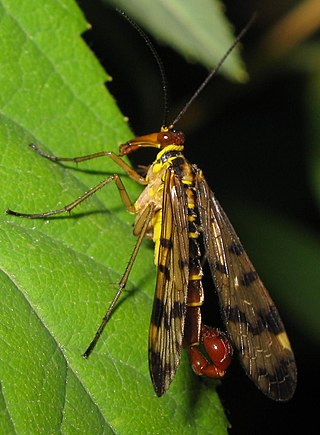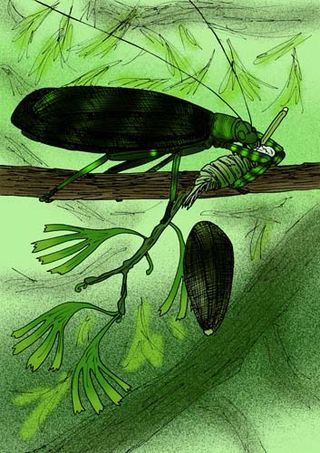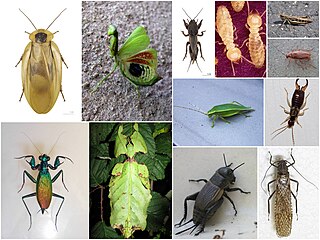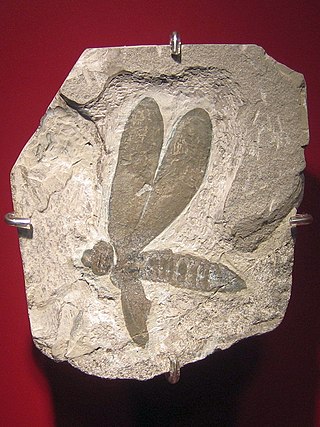
The insect order Neuroptera, or net-winged insects, includes the lacewings, mantidflies, antlions, and their relatives. The order consists of some 6,000 species. Neuroptera is grouped together with the Megaloptera and Raphidioptera (snakeflies) in the unranked taxon Neuropterida.

Endopterygota, also known as Holometabola, is a superorder of insects within the infraclass Neoptera that go through distinctive larval, pupal, and adult stages. They undergo a radical metamorphosis, with the larval and adult stages differing considerably in their structure and behaviour. This is called holometabolism, or complete metamorphism.

The family Prophalangopsidae are insects belonging to the order Orthoptera. They are the only extant members of the superfamily Hagloidea. There is only one extant genus in North America, where they are known as grigs, four genera in Asia, and many extinct genera.

Ensifera is a suborder of insects that includes the various types of crickets and their allies including: true crickets, camel crickets, bush crickets or katydids, grigs, weta and Cooloola monsters. This and the suborder Caelifera make up the order Orthoptera. Ensifera is believed to be a more ancient group than Caelifera, with its origins in the Carboniferous period, the split having occurred at the end of the Permian period. Unlike the Caelifera, the Ensifera contain numerous members that are partially carnivorous, feeding on other insects, as well as plants.

The Caelifera are a suborder of orthopteran insects. They include the grasshoppers and grasshopper-like insects, as well as other superfamilies classified with them: the ground-hoppers (Tetrigoidea) and pygmy mole crickets (Tridactyloidea). The latter should not be confused with the mole crickets (Gryllotalpidae), which belong to the other Orthopteran sub-order Ensifera.
Michael S. Engel, FLS, FRES is an American paleontologist and entomologist, notable for contributions to insect evolutionary biology and classification. In connection with his studies he has undertaken field expeditions in Central Asia, Asia Minor, the Levant, Arabia, eastern Africa, the high Arctic, and South and North America, and has published more than 925 papers in scientific journals and over 1000 new living and fossil species. Some of Engel's research images were included in exhibitions on the aesthetic value of scientific imagery.

Cicadomorpha is an infraorder of the insect order Hemiptera which contains the cicadas, leafhoppers, treehoppers, and spittlebugs. There are approximately 35,000 described species worldwide. Distributed worldwide, all members of this group are plant-feeders, and many produce either audible sounds or substrate vibrations as a form of communication. The earliest fossils of cicadomorphs first appear during the Late Permian.

The Berothidae are a family of winged insects of the order Neuroptera. They are known commonly as the beaded lacewings. The family was first named by Anton Handlirsch in 1906. The family consists of 24 genera and 110 living species distributed discontinuously worldwide, mostly in tropical and subtropical regions. Numerous extinct species have also been described. Their ecology is poorly known, but in the species where larval stages have been documented, the larvae are predators of termites.

Titanoptera is an extinct order of neopteran insects from late Carboniferous to Triassic periods. Titanopterans were very large in comparison with modern insects, some having wingspans of up to 36 centimetres (14 in) or even 40 centimetres (16 in).
The Madygen Formation is a Late Triassic (Carnian) geologic formation and Lagerstätte in the Batken and Osh Regions of western Kyrgyzstan, with minor outcrops in neighboring Tajikistan and Uzbekistan. The conglomerates, sandstones and mudstones of the 560 m (1,840 ft) thick formation were deposited in terrestrial lacustrine, alluvial, fluvial and deltaic environments.

Cantabroraphidia is an extinct genus of snakefly in the family Mesoraphidiidae. The genus is solely known from fossil amber found in Cantabria, northern Spain, dating to the Albian age of the Early Cretaceous Period. Currently the genus comprises a single species Cantabroraphidia marcanoi.

Mesoraphidiidae is an extinct family of snakeflies in the suborder Raphidiomorpha. The family lived from the Late Jurassic through the Late Cretaceous and is known from twenty-five genera. Mesoraphidiids have been found as both compression fossils and as inclusions in amber. The family was first proposed in 1925 by the Russian paleoentomologist Andrey Vasilyevich Martynov based on Upper Jurassic fossils recovered in Kazakhstan. The family was expanded in 2002 by the synonymizing of several other proposed snakefly families. The family was divided into three subfamilies and one tribe in a 2011 paper, further clarifying the relationships of the included genera.

The Protocoleoptera are a paraphyletic group of extinct beetles, containing the earliest and most primitive lineages of beetles. They represented the dominant group of beetles during the Permian, but were largely replaced by modern beetle groups during the following Triassic. Protocoleopterans typically possess prognathous (horizontal) heads, distinctive elytra with regular window punctures, culticles with tubercles or scales, as well as a primitive pattern of ventral sclerites, similar to the modern archostematan families Ommatidae and Cupedidae. They are thought to have been xylophagous and wood boring.
This list of fossil arthropods described in 2010 is a list of new taxa of trilobites, fossil insects, crustaceans, arachnids and other fossil arthropods of every kind that have been described during the year 2010. The list only includes taxa at the level of genus or species.

The cohort Polyneoptera is a proposed taxonomic ranking for the Orthoptera and all other Neopteran insects believed to be more closely related to Orthoptera than to any other insect orders. These winged insects, now in the Paraneoptera, were formerly grouped as the Hemimetabola or Exopterygota on the grounds that they have no metamorphosis, the wings gradually developing externally throughout the nymphal stages.

Permopsocida is an extinct order of insects known from the Early Permian to the Mid-Cretaceous. It is part of Paraneoptera, alongside bark lice, bugs and thrips. Within Paraneoptera it is considered to be closer to the clade containing bugs and thrips rather than bark lice, with an estimated divergence during the Late Carboniferous. The group was first named as a suborder by Robert John Tillyard in 1926, and was raised to a full order by Huang et al. in 2016. It is currently divided up into three families, Psocidiidae which is known from the Permian to Liassic. Permopsocidae which is only known from the Permian, and Archipsyllidae, which is known from the Late Triassic to mid-Cretaceous (Cenomanian). While most members of the group are known from compression fossils, several members of Archipsyllidae are 3 dimensionally preserved in Burmese amber, which has helped clarify the morphology and phylogenetic position of the group. The morphology of the mouthparts suggests that they were capable of suction feeding and chewing, with preserved angiosperm pollen grains in the gut of Psocorrhyncha suggesting that at least some members of the group were pollenivorous.

Elcanidae are an extinct family of Mesozoic and early Cenozoic orthopterans. Members of the family are distinguished by the presence of spurs on the distal part of the metatibia, unique among orthopterans, these have been suggested to have been used for controlling gliding, swimming aids, or for jumping on water. The group combines characteristics from both major groups of orthopterans, with long antennae and nymphal morphology similar to Ensifera, but with wing venation and adult morphology more similar to Caelifera. Elcanidae is part of Elcanoidea, which is thought to have diverged from living orthopterans by the beginning of the Permian, around 300 million years ago. The family also includes Permelcanidae, known from the Early-Late Permian. The relationship of Elcanoidea to Ensifera and Caelifera is currently unresolved. Elcanids are known from the Late Triassic to Paleocene of Eurasia, North and South America. Some members of the group exhibited aposematic coloration.

Caloneurodea is an extinct order of polyneopteran neopteran insects in the superorder Orthopterida. The Caloneurodea are known from fossils found in North America, Europe, Russia, and Asia and had a palegeographic range confined to Laurussia.
Geinitziidae is an extinct family of polyneopteran insects, known from the Permian to Cretaceous. They are currently considered to be members "Grylloblattida" a poorly defined group of extinct insects thought to be related to modern ice crawlers (Grylloblattidae). Other authors place them in the extinct order Reculida. Unlike modern ice crawlers, which are wingless, they had large wings, bearing a superficial resemblance to cockroaches, and are thought to have been day-active above ground predators.
This list of 2023 in paleoentomology records new fossil insect taxa that are to be described during the year, as well as documents significant paleoentomology discoveries and events which occurred during that year.















